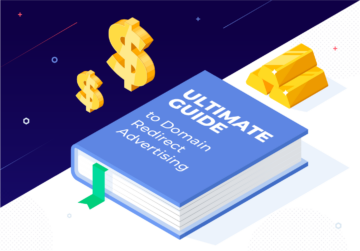Are you’re wondering how to run domain redirect traffic ad campaigns? If the answer is yes — you’re in the right place, at the right time. This complete guide will take you through the basics of domain redirect ads and give you all the necessary knowledge to start and scale your first zero-click campaigns.
You ought to know that domain redirect advertising targets people who have already shown a subtle dose of interest in certain products, which ultimately increases your chances of user engagement. And since the ultimate goal of running ad campaigns is to make a profit, you should obviously focus on what’s working best for you. Stop loitering around and take action.
Read this Ultimate Guide to Domain Redirect Traffic and learn how to make the most of your zero-click ad campaigns in 2022!
What’s domain redirect traffic?
Domain Redirect Traffic, also known as zero-click traffic or parked domain advertising, is an ad format based on redirecting users from parked domains to landing pages promoted by the advertisers.
But how is this traffic generated? Well, a journey to the desired moment of displaying an offer page to a potential customer requires a few companions: a publisher (domainer), an affiliate network (optionally), an advertiser, and a user.

How is domain redirect traffic generated?
Publisher’s perspective
As in every business, there obviously need to be two main parties: the buyer and the seller. When it comes to domain redirect advertising, parked domain owners come onto the stage as the publishers.
But, what are parked domains and where do you get them from? There are two ways, publishers can either create or buy parked domains. Allow us to give you a brief explanation.
Securing a domain’s name is usually the first step in creating a website. That’s what domain registrars are for. A domain registrar is usually a company responsible for managing registering, reserving, and selling Internet domain names. These companies link domain names to temporarily parked domain websites so that in case a user types in a particular URL, a parked domain website is displayed.
Now, this is where ad traffic monetization comes into play. Parked domains using URLs similar to well-known brands, well-searchable phrases, or simply their misspelled versions tend to drive more traffic to ads displayed there. But be careful with fraud accusations! You can also save yourself the trouble and buy parked domains from people who aggregate those without entering the affiliate business. Again, it all depends on your skills, resources, time, energy, and goals.
In any case, the moment you contact an ad network is the moment you start monetizing your parked domain’s traffic. They act as middle-parties in the publisher-advertiser relation aggregating inventory from various sources (publishers) and then offering it to the advertisers. Supply meets demand, and it’s a traffic network’s job to do it right.
[blog-banner id=”4716″ name=”zp-bfcm-in-text-banner-with-deals”]
Advertiser’s perspective
Now let’s have a look at how domain redirect advertising looks from the advertiser’s perspective, which is exactly why you’re reading this article. Having a bit of background knowledge and a look at the publisher’s take on how parked domains are created and why use them for displaying ads is much recommended. So here’s how the magic happens.
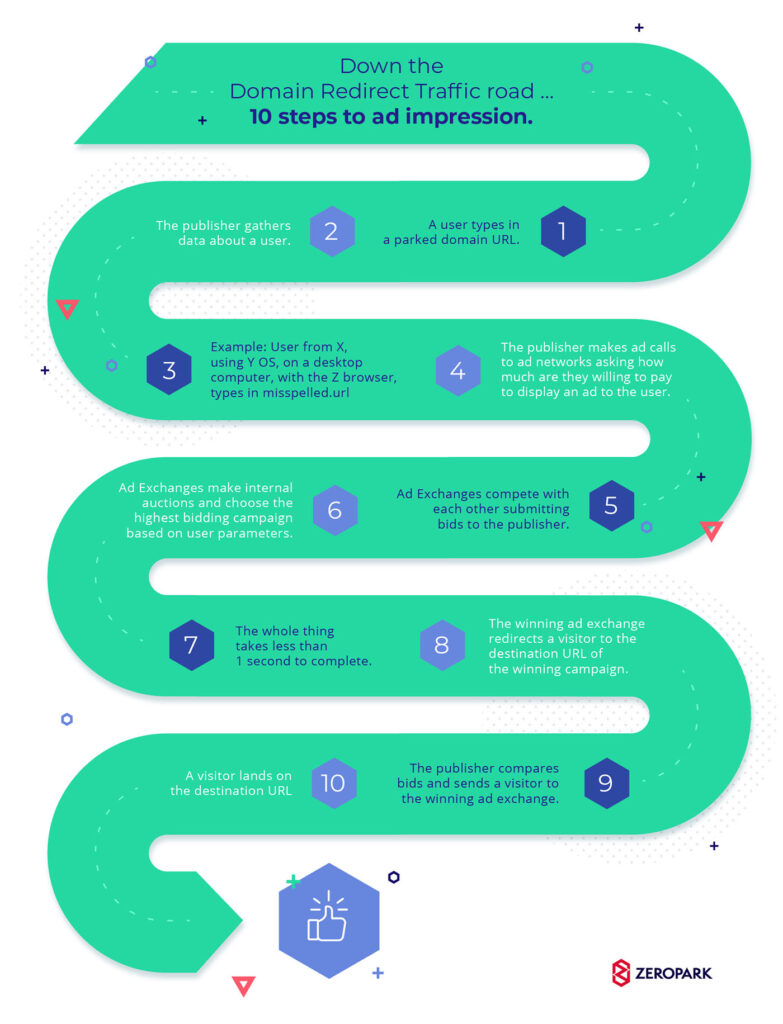
The entire process of parked domain redirection takes under a second with other things also happening in the meantime.
- First, a user triggers redirections by typing in a URL in the address bar of a browser. It often happens that users simply misspell popular or akin domain names or perform online searches by entering such. If the input matches a parked domain name, created or aggregated by publishers, a user is taken to that domain.
- Once a redirection is triggered and a parked domain website starts loading, a real-time bidding (RTB) auction among the advertisers begins. Mind that all this happens within the splits of seconds. Then, while a page is loading, a winning advertiser’s offer is selected and a user gets redirected straight to the highest bidder’s landing or offer page.
Zero-click traffic is in fact caused by the user’s proactive search, thus allowing affiliates to reach audiences more probable to engage with displayed offers. Meeting the right traffic with the right audience can’t seem to get any easier, can it? That’s a whole process in a nutshell, of course. But since we’re here to give you a thorough explanation of all events, including those undetectable to the human eye, here’s a slow-motion look at an RTB auction.
Real-Time-Bidding — the road to an ad impression.
A real-time bidding auction is a bidding model where advertisers bid for ad displays in real-time. Within fractions of a second, as the website loads, requests are sent and bids received. The highest bid wins and the winner’s ads are immediately displayed to users entering a publisher’s website. The RTB auction enables advertisers to broaden the reach of their ads and the publishers to get the best value for it.
In order to get a full grasp of what an RTB auction is, we need to include both an SSP (Supply-Side Platform) and a DSP (Demand-Side Platform). For zero-click traffic, these would be parked domain owners and advertisers willing to display their ads via redirections.
It’s worth noting that the implementation of the Real-Time Bidding auction model has revolutionized the ad tech business. It lowered the costs, increased demand, and opened new targeting options — all leading to boosting affiliate ad campaign performance and maximizing profits.
In order to trigger an RTB auction with domain redirect advertising, we need at least three parties: a buyer, a seller, and a middle man. At least refers to the middle party, an ad exchange platform, which enables the auction to an infinite number of participants on the DSP side — advertisers. Meaning, there can be numerous bidders to the publisher’s offer, and the highest bid wins. Luckily, advertisers do not face the risk of having their bids inflated beyond what they’re able to pay since bid caps are set prior to an auction.

The advantages of the RTB auction model for the DSP side include:
- More control over impression bought hence less wasteful spending.
- Better targeted, thus better-performing campaigns.
- SSP’s control, since advertisers have now a say in whose traffic they want to buy.
From an SSP, meaning the publisher’s side, this scenario is a win-win situation as well — the highest offer wins. This allows publishers to take full advantage of their inventory as well as control the quality of ads being displayed there, thus the sort of internet traffic drawn.
The advantages of the RTB auction model for the SSP side include:
- More data’s being gathered, thus allowing for better targeting.
- Increase of inventory value thanks to more precise targeting options.
- DSP’s control, since publishers now have a say in what kinds of ads are displayed.
An ad exchange, which can be called a digital marketplace, in this case, is a place enabling all this magic to happen. Also, it makes sure the best interest of both the SSP and DSP sides is secured.
Learn More About The Processes Behind Ad Impressions With Domain Redirect Traffic.
Domain Redirect vs Pop — which ad format is better?
Why is it worth comparing domain redirect traffic to other options available? Because making conscious choices is super important for affiliate marketing. With the industry’s dynamics and real money auctions happening within seconds, there’s little room for random decisions. If you’re still not quite set for running your affiliate ad campaigns with domain redirect traffic, you most definitely should keep on reading this article. There’s a reason it’s called an ultimate guide to parked domain advertising, after all.
Start with juxtaposing a potential choice with alternative inventory types before making your final decision is a good call. Remember, know your goals well and choose accordingly. This is why we want to bring you a quick comparison of domain redirect with the all-time pop ads traffic. Why pop traffic in particular? Pop ads occupy the largest space of the affiliate marketing inventory. Their volumes are much bigger, and prices much lower than with other formats offered by ad networks.

User’s perspective
When comparing domain redirect and pop ad traffic from the ad recipient’s perspective, they might actually seem quite alike. In both cases, ads are displayed in the form of a new tab or a browser window, reverting user attention to products promoted by affiliates. The devil’s in the details, though. The two most common formats of pop ads are of course pop-ups and popunders. These may be initiated automatically due to a toolbar or a plugin users have installed in their browsers, or if a user clicks on the specified area of a webpage. So, the initiation and redirection scheme between the two traffic types is already a bit different.
Another thing slightly different for pop is its format depending on the device type (with zero-click traffic redirections are triggered in the same way for both mobile and desktop). If pop ads are triggered on desktop, a new browser window appears over a currently viewed page (pop-ups) or beneath it (popunders). Whereas on mobile, it’s usually a tab-up or tab-under opening in our existing browsing window.
Advertiser’s perspective
Now, looking at parked domain and pop ads advertising from the advertiser’s perspective, differences in volumes and prices of the two types of traffic may be of crucial importance. Naturally, both ad types offer large volumes of available traffic, yet pop’s volumes are substantially bigger. Numbers don’t lie — as Zeropark’s Traffic Calculator shows, it’s ca. 48 billion on pop vs. 1.5 million on domain redirect. Still, there’s a good reason for it. This much visible difference between zero-click traffic’s available monthly redirections and pop ads volumes is caused by differences in traffic’s nature and targeting strategies.
Zero-click traffic offers a much smaller, yet more targetable audience. Pop ad advertising gives affiliates a much larger number of potential users, yet it’s much more general and less targetable. This means that significantly bigger volumes of users need to see your pop ads in order to convert, than with a domain redirect ad campaign. Knowing your audience and understanding their way of thinking allows you to predict user behavior and make the best choices for your affiliate ad campaigns. When it comes to the cost, the case is similar. Although both ad formats offer Cost-Per-View or Cost-Per-Mille cost models, and the Real-TIme-Bidding auction process is exactly the same, the average bid prices vary notably.
Comparing the same setup, e.g. Adult traffic for the US on Desktop, we find out that with the current prices and traffic available, domain gets us ca. 8.7k visits, while pop gives us ca. 111 111k available monthly impressions. Hence, domain redirect advertising offers a much smaller, but more targetable audience. That’s why the average bid prices are higher. Pop traffic, on the other hand, gives advertisers a much bigger, and more general audience, with much cheaper bids. Depending on what your goal is, e.g. testing or reaching a niche, choose an option that’s more suitable for you.
In Zeropark, for example, one major difference between domain redirect and pop traffic is the fact that only pop gives affiliates a chance for buying traffic from the selected Inventory Types. The four available options are Premium and Standard inventory types. Thanks to the machine learning process, some ad networks are able to select the best sources to propel your campaigns with. They’re usually chosen on the basis of their performance in a given time frame, regarding the best-performing GEOs, and then divided into Tiers so as to categorize what’s worth buying the traffic from and what’s not. Such division gives advertisers an idea about potential costs, volume, and performance of pop traffic.
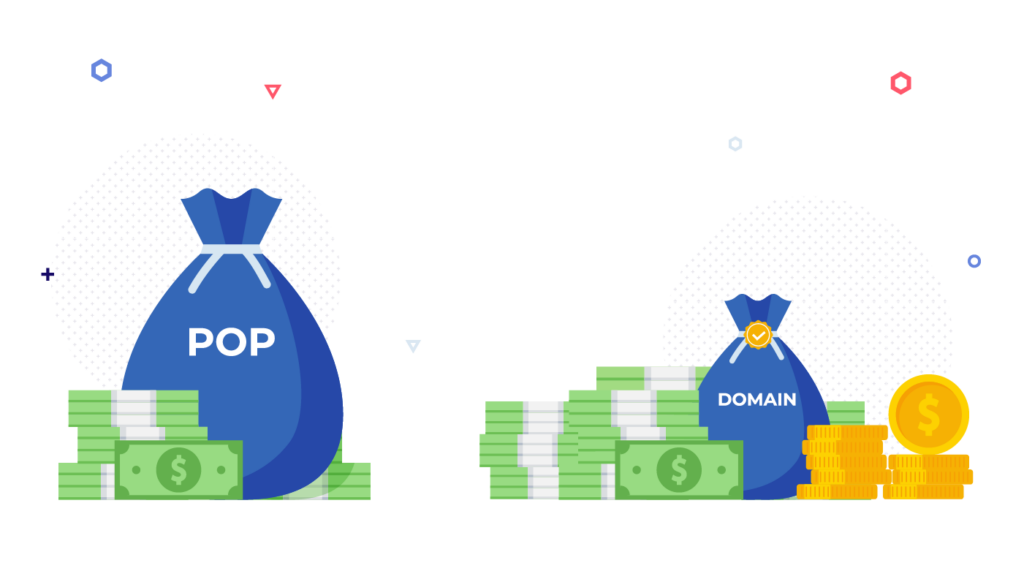
Comparison findings
A good practice would be combining that knowledge with setting Rule-based optimization if/when patterns, helping you secure the maximal automation while resting assured your advertising budget isn’t going to be burnt before you even have a chance to spot a sudden change in the market.
Although this option is assigned to pop traffic only, you can easily perform very similar research for zero-click traffic as well. Yes, it does require a bit more effort and digging but results thus obtained might be of crucial importance to boosting your domain redirect traffic ad campaign performance and maximizing its ROI.
Use a Traffic Calculator, observe affiliate marketing industry trends, research affiliate community forums, or talk to your traffic source representatives. With the shifting sands of the affiliate marketing industry, staying up to date with the latest changes is essential anyhow. Digging into the Pop vs. Domain subject seems like a good idea to start with before you head into parked domain advertising full steam ahead.
Hence, the following can be listed as the two ad formats main differences and similarities:
- Both pop and domain can be run on broad, narrow, whitelist, or keyword targeting, allowing to run the testing phase and then optimize to scale up.
- Pop traffic allows you to buy much bigger volumes of available monthly impressions for a cheaper price, which might be useful for testing.
- Domain redirect traffic allows for addressing better-targeted audiences since users tend to perform a proactive search themselves.
- Thus, parked domain advertising secures higher interest and user engagement with the viewed offers, proven to work well especially with Target/Source and Keyword targeting.
- Pop traffic allows tiers, inventory types, and verticals to be categorized and differentiated in price and performance. It might be useful as a sure-fire solution with broad targeting.
- Parked domain advertising increases chances for getting high engagement due to its relevancy and lack of redirect blocking. This results in higher bid prices, but quality traffic with a good potential to skyrocket your ROI.
Summing up, every clever affiliate needs to understand that the costs, performance, and overall behavior of ad campaigns, be it domain redirect, pop traffic, depends on many variables, e.g. inventories, volumes, bid prices, tiers, verticals, targeting, testing, etc. Most of all, don’t be afraid of spending money. This business is not about what’s cheaper, but what’s more profitable.
Still Not Sure Whether To Go With Pop Or Domain Traffic? Read Further About The Two!
 What do you need to start a domain redirect traffic ad campaign?
What do you need to start a domain redirect traffic ad campaign?
Having made a conscious and thoroughly thought out decision to start your domain redirect traffic journey, now it’s time to think about what’s worth taking with you. It’s like one of those questions — what would you pack to survive a weekend on a deserted island?
Follow these steps while preparing to launch your parked domain advertising campaign and you’ll be able to survive in this industry way longer than Robinson Crusoe on Más a Tierra island.
Asking a few questions should help for a start, try the following ones. Next, think of your answers and what they’re telling you. It might be an essential step in identifying your goals and taking suitable actions.
- How experienced am I with affiliate marketing?
You don’t need to be an old hand who’s already preaching the parked domain advertising, but some knowledge of the affiliate industry is already a huge help. If your answer to that question is the ultimate nada … then you’re definitely in the right place, at the right time. Keep on reading this ultimate guide to zero-click traffic and you’ll be sorted to start your domain redirect ad camping in no time.
- Have I run zero-click traffic ad campaigns before?
If you’ve run zero-click traffic ad campaigns before, then refreshing your information or simply having a second look at it is much recommended. Oh… you haven’t heard about where these parked domains actually come from? Well, now you have. Alternatively, if you’ve never done parked domain advertising, it’s high time you gave it a go. Keep on reading and you’ll know perfectly well how to do that in style.

- What’s my budget? Is testing included?
Money is a sensitive subject — whether at the family’s dinner or during a first date. Well, luckily you don’t have to discuss your affiliate advertising budget during any of those. Do talk about it to your traffic source representative or see what other affiliates recommend at community forums. Research, check, calculate and then recalculate. Don’t forget to take the testing phase into account! See how much you’d be able to spend on it and for how long you’re able to afford it.
- Am I looking for quick or steady profit?
This might be of tremendous importance for your campaign performance. Making quick yet short lasing or steady and long-term profit involves two different approaches and various testing, targeting, and optimization practices — not to mention investment and bidding strategies. For quick, go for the given moment’s hottest trends (offers, verticals, GEOs). For long-lasting solutions, careful testing and optimization are a must.
- Am I going for tried and tested solutions or exploring a niche?
That is entirely up to you, but don’t let your whim be decisive. Which option it’d be better to go for depends on your experience, budget, testing, targeting, and optimization skills. You might be just discovering a six-figure making niche or drowning all your money. Look before you leap!
Want To Get Even More Detailed Overview Of What You Need To Start With Domain Redirect Traffic? Read here!
Finding the best offers to run with domain redirect traffic.
Once you know how you feel about domain redirect traffic, it’s time to choose offers. But how are you supposed to know which one’s the best with a multitude of offers out there? Especially they tend to be similar to what tens of other affiliates promote, too.
Why? Because what works for tens of people should probably work for you, too. Here are some industry insights to help you make the best decisions and enhance your affiliate efforts right at the start.

What verticals should I choose?
One of those affiliate industry tricks is focusing on relevant verticals. Knowing your audience helps to address it in the best possible way. Verticals help you, an affiliate advertiser, classify what kind of audience will receive your ads.
Remember when you were a kid and people would ask you who you wanted to become in the future? Well, becoming an affiliate marketer probably wasn’t your answer. But if you happened to mention becoming a psychologist, that must have been a sign! That’s exactly what you need to do as an advertiser.
Think about what and how the potential viewers of your ads would think or do. Predicting their needs and reactions. Coming up with solutions to their problems is what gets you conversions.
Where should I run my campaigns?
Another one might be aligning offers with GEOs. It’s actually quite simple — where do you think flip flops are needed the most? Or winter hand gloves? Or maybe both? That means targeting three different GEOs. Giving people what they want and need is a sure-fire solution. Obviously, you’re most welcome to revolutionize the industry by hitting the numbers promoting flip flops in Antarctica, but if you don’t have money to burn stick to Miami perhaps.
When should my campaigns be active?
Here’s the thing — you wouldn’t want to promote skiing gear, in a form of sweepstakes, in Malaysia, around July time… just because it seems cheap. Think before you act.
Instead, running an e-commerce domain redirect campaign for the US market, especially in Q4 (the so-called Golden Quarter with its Black Friday, Cyber Monday, and Christmas craze) sounds much more reasonable. Actually, it sounds pretty clever because timing is everything!
Especially that Sweepstakes, Downloads, or E-commerce are the proven verticals for domain redirect traffic. Again, don’t try to reinvent the wheel. Of course, bigger competition may also mean inflated prices and smaller volumes available, but if you bid smartly this shouldn’t be an issue.
If you want to learn more about how to make money with e-commerce and domain traffic click here.
Should I look for a niche audience?
Yes, get yourself a niche! Don’t just talk to everyone, everyone doesn’t care. Promoting specific products to specific people increases your chances of conversion, thus profiting. Think of the hot verticals, steaming offers, and take a peek at what your competition is doing behind the curtains. Remember — health, wealth, and romance are never dead.
The affiliate marketing niche is a narrow segment of the digital marketing audience. Such groups of potential customers share mutual interests in very specific products. Identifying them, thus the niche and these unique interests allow affiliate marketers to pick offers such users would most likely engage with. Promoting specific products to specific people increases your chances of conversion, thus profiting.
With the abundance of products and services available within a couple of clicks away, people don’t want them anymore. People want solutions, and they want them tailored especially for them. Answering this demand with the proper supply seems to be quite a reasonable step. But how do you answer people who have everything and don’t actually know what they’re looking for?
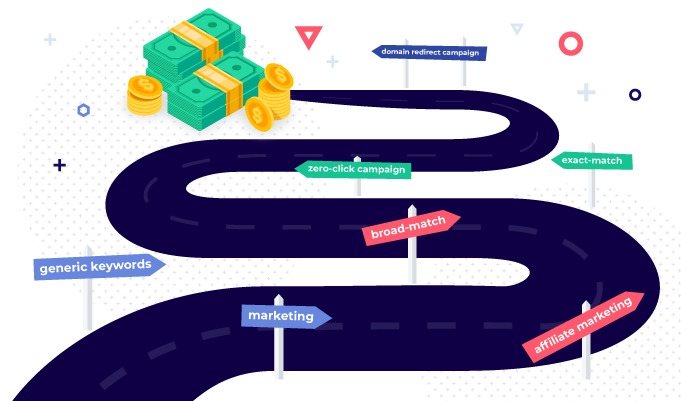
“A lot of times, people don’t know what they want until you show them.” – Steve Jobs
Finding a niche is one way to go, creating a new one is taking your affiliate efforts to the next level. And Steve Jobs seems to be a perfect example of how creating a niche, got him just the demand he needed for his technological supply.
Hence, making a niche-targeted ad answer specific problems adhering to the niche audiences’ passion or providing them with a solution seems like a way to go. Try to find a niche within verticals recommended for domain redirect ad traffic (e.g. Sweeps and Surveys, E-Commerce, Travel, or Dating).
Maybe a special Black Friday sweepstake or an offer to promote a retail shop discount? There’s quite a field to get even more granular with that. How about sport and travel equipment, also lots of choices for much greater segmentation.
And since romance is never getting old, do your research well before Christmas or Valentines’ craze hits. There are as many possibilities for finding a niche as there are searches performed on the Internet — thank you very much, Google Trends! You should get your research going and really step out there looking for the perfect combination for your parked domain ad campaigns.
Learn More About How To Choose The Best Offer For Your Domain Redirect Ad Campaigns Here!
Choosing a traffic source for a domain redirect ad campaign.
The art of matchmaking in the affiliate marketing business is volatile. Finding the right traffic source for your domain redirect ad campaign requires making some serious decisions. That’s why pairing with a credible and trustworthy partner is the key to a long-lasting and happily ever after cooperation.
What to look for in a traffic network of affiliate dreams? The list may be long and differing depending on one’s needs. There are certain aspects that seem to be indispensable, and those we could possibly live without … but why make your life more difficult if we have all these new features and automation tools delivered on a silver platter.
Still, asking a few questions should make the decision process go smoothly.
AD FORMATS: Start by asking if a given traffic source offers domain redirect advertising at all. Not all of them do, offering other ad formats instead, so this simple yet quite needed call has to be made.
COMPLIANCE RULES: Make sure you know what’s allowed and what’s not — compliance rules and regulations are also a sign of credibility and high-quality traffic. If you’re planning to run adult traffic campaigns only make sure it’s available, the mainstream traffic option is definitely not for you.
When deciding which traffic source to choose, ask how your parked domain campaigns get approved. Are you able to learn what’s allowed and what’s prior to signing up with? Or how long does it take to verify your domain redirect ad campaigns? Whether you’d be able to come back with the same campaign after it was rejected and knowing who or what makes the final call (person or an AI-powered algorithm) should also give some food for thought as well.
VERTICALS, ANGLES, AND NICHES: Next, check if verticals, angles, and niches match your domain traffic ad campaign goals. Don’t go skiing in Malaysia, instead go shopping on Black Friday. Being able to promote the right offers to the right audience at the right time is the key to every kind of marketing. Investigate which verticals, angles, and niches go best with parked domain traffic. Then make sure a traffic source of your choice allows you to choose angles suitable for parked domain traffic.
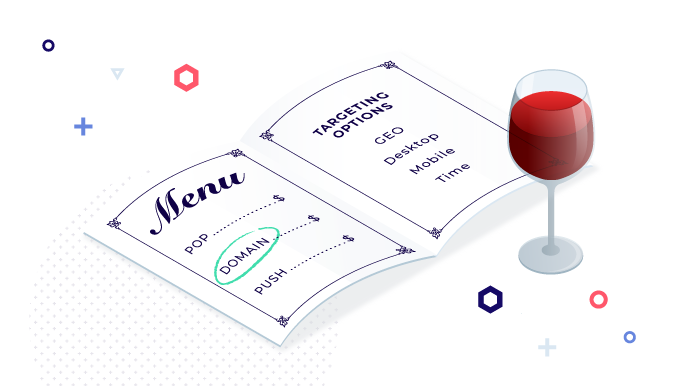
VOLUMES OF TRAFFIC: Once you’re able to run offers from the verticals proven to perform well with zero-click traffic, buy as much traffic as possible. Obviously, the higher the competition, the higher the prices. Unless you’re targeting a niche nobody else has yet heard about. In such a case, know how much parked domain traffic a network has in stock for you and how much it would cost you. That’s why estimating the available volumes of traffic before choosing a traffic source is a key element of the process. If your potential partner is able to secure the supply you’ll be able to scale up your zero-click campaigns.
COST: Calculate how much would a zero-click traffic ad campaign cost with a traffic source of your choice.
The basic questions you should ask refer to:
- entry deposit,
- minimum top-up,
- payment methods.
Later on, it’s also worth making sure about:
- volumes of domain redirect traffic,
- quality of traffic
- domain traffic’s cost-model,
- estimated cost-per-bid,
- potential issues with overspend,
- support responsiveness and quality.
Putting all these pieces of the puzzle together we can estimate how much a zero-click campaign would cost us. Next, ask yourself if you know how to use the platform. Working with an intuitive and user-friendly interface is much more efficient. Also, the onboarding and ongoing support might be crucial for scaling up your campaigns.
TARGETING OPTIONS: Knowing what targeting options a traffic source is able to offer you may be important if you’re planning on very specific targeting or running a niche zero-click traffic ad campaign.
The following options seem to be the usual set, so make sure these are included:
- Geo-targeting (the more depth, the better)
- Desktop device targeting
- Mobile device targeting
- Adult or non-adult filtering
- Frequency filtering
More targeting options equals more chances for slicing the data and drilling through the best-performing setups to boost your domain redirect ad campaign’s performance. The good news is that with the ever-growing competition amongst such traffic platforms themselves, continuous upgrades are required, which means even more improvements to come.

QUALITY: Quality comes for a price — there’s no denying it. That’s why comparing various traffic networks is much recommended. Research any discrepancies in prices. If what’s actually pretty expensive with others is much cheaper with one network, there might be some shady business happening on the side. Nobody wants their budget spent on poor quality traffic the ROI to be down in the dumps. If there’s anything wrong, other affiliate marketers have probably already heard about it and can help you out. But be wise and use your own judgment when making such decisions for your zero click traffic ad campaigns!
USER EXPERIENCE: Does a traffic network offer a user-friendly platform? How would you know if you haven’t made up your mind yet or signed up with any? Well… trustworthy platforms usually offer a free preview or demo. They do not want to scam people into paying in their deposits and then leave. Long-term relationships with their customers mean it’s probably worth giving such a network a go. Know what you’re buying prior to spending money. Again, ask a few questions regarding what a traffic source has in store for you:
- Does it have all the parameters you need to reach the peak performance of your zero-click traffic ad campaigns?
- Do all the buttons and segments make sense to you?
- Do the columns with strings of data tell the tale of the ups and downs of your affiliate efforts?
- And finally, are you able to see the direction your domain redirect jet is heading in?
SUPPORT: A reliable traffic network should definitely provide you with technical documentation resources, video tutorials, or onboarding support to start with and then offer continuous guidance and help of designated representatives. Find a traffic network that helps you scale up your domain traffic ad campaigns and reach peak performance while boosting the ROI.
EXTRAS: With the competition on the affiliate market, traffic sources keep coming up with constant improvements. The anti-fraud filtering kit is one of them, also working in favor of your traffic’s quality.
Next, the rule-based optimization options are definitely worth your attention. They allow for pre-setting certain action flows and ensure that your campaign budget is not burnt, bids are adjusted automatically, daily spend caps are kept and the right decisions are followed.
Also, campaign testing tools are of great benefit allowing affiliates to see if all the tokens and parameters needed for correct conversion tracking are set right. This helps avoid inadvertent mistakes and missing out on your parked domain campaigns profit.
TRACKER: Having a tracking solution is an absolute must! Keeping track of data is essential. Making sense of it and knowing how to read it, and later make sense of it, is even more important. Using a proper affiliate tracking solution (e.g. Voluum) does not only allow you to gather much-needed data, but also saves your time in manual optimization and helps identify areas to improve and to scale up. Simply, if you don’t track you don’t know where you’re making money and where you’re losing it.
Also, certain automated optimization solutions traffic networks offer are only possible to use if conversion data is tracked. Machine learning processes require data to later self-optimize according to recorded trends. With parked domain redirect advertising, using the Rule-based optimization feature may prove quite effective if the system is, in fact, able to record conversion patterns and set the most optimal strategy.
So now ask yourself this: Does a traffic source of my fancy check all my domain redirect ad campaign boxes? If yes, then it’s time to couple up.
How to ensure a good landing page performance in Domain Ads?
So you’ve paired with a traffic source and you’ve got a plan. It’s time to get ready. Oh, wait — first impressions count the most, remember?

While working on your domain redirect ad campaign and preparing your money-making landing pages don’t forget to focus on the visual aspects. Make sure you don’t skip the following:
- Page loading speed — it doesn’t matter how perfect your lander is if it takes ages to load and users switch it off before it even has a chance to display the offer it’s promoting.
- Optimization — limit HTTP requests, optimize visuals, use asynchronous loading for JS and CSS elements, reduce the number of WordPress plugins (they do have an impact on the loading speed!), use file compression, minimize redirects so as not to tire users.
- Hosting — use quality servers to ensure stability, quickness and broaden your reach.
- Content is king — motivate users, show them it’s worth it, make their lives easier, optimize for mobile, always keep your CTA above the fold, be credible, be neat — no place for shady grammar there.
- Use translation tools to have your landers understandable for various viewers — saves time and energy.
- Don’t forget spy tools — they’ll save your time, money, and energy figuring out the best designs and strategies.
This may also be important for your domain redirect ad traffic campaigns. That’s why make sure you watch out for the following while preparing your landing pages.
Landing pages are just like first impressions — their meaning is huge. They’re the meeting point of a user and an offer, thus the exact spot where you’re making a profit. Keeping them neat, engaging, quick to load and straightforward is an absolute must. Add crisp copy and a clear CTA to rock your domain redirect ad traffic performance! If you want to create a more professional look and brand image, you can use a custom domain for your landing pages. This will give you a unique web address that reflects your brand and makes it easier for your audience to find you online. Additionally, by using a custom domain, you can increase your credibility and trustworthiness with your visitors. So, make sure to consider this option when creating your landing pages.
Know how and when to use spy tools.
Researching the market and having a little lurk into what the competition is doing should be on every business’s to-do list. Everybody does that, all the time, in all kinds of industry — affiliate marketing being no different. But how to do that?
![]()
Well, every business has its secrets, but people aren’t usually very keen on revealing how they obtained information that was supposed to stay hidden. With ideas worth billions of dollars, like Facebook or Amazon not to look too far from our own digital pond, many would literally die to be the first ones to come up with. And although being just a blade of grass compared to the global giants, there are even more lookalike companies. Having a sneaky peek into your competitor dwellings may turn out quite profitable, then.
Fear not — luckily for the affiliate marketing industry, we’ve got spy tools to aid with the struggle.
Using these handy tools should become your practice regardless of whether you’re an experienced marketer or a budding affiliate. The digital marketing world, affiliate marketing included, is a rapidly changing environment that requires continuous monitoring not to miss out on the newest trends.
Spy tools give you insights into what and how your competition is promoting at the moment, what choices they make for their affiliate ad campaigns, and you’d obviously look for anything related to parked domain advertising.
What would be of special interest to you as an affiliate promoting zero click traffic? Keywords and visuals.
Make use of data gathered and:
- See what keywords and creative strategies are widely used.
- Evaluate whether what your competition is doing would work for you, too.
- If yes, think about how would you be able to use that knowledge.
- If not, think about what would be a better solution.
- Do not copy and paste exactly the same materials!
- Adjust and optimize your competition’s examples to the type of domain redirect ad campaign you’re planning to run.
Spy tools may be a perfect solution for both people who could already preach the subject of affiliate marketing and the ones who are still researching all the community forums looking for the best advice on solving any newbie-related issues. Spy tools allow for a quick increase in profits as well as staying ahead of the curve of upcoming trends.
Money, time, and ideas for running the best domain redirect ad campaigns are what every clever affiliate is looking for. And spy tool allows you to save exactly those.
- You’re able to increase profits by optimizing your creative approach and reduce costs by avoiding spending money on patterns that simply wouldn’t work.
- You’re able to save time by having a clear view of what’s your competition cooking, as well as being able to skip on testing patterns (which also costs money) that you’re able to identify with the help of spy tools anyway. Not to mention the option to simply download and deploy ready-made patterns, which should be done within reason, though.
- Ideas are hard to evaluate, but may often turn out priceless. What if you’re not the best at coming up with such solutions? Or what if your vision takes you way too far to another galaxy? Well, whether you need to give your creative ideas a little push or rather keep them in line, helping yourself with spying tools may be a great way to score both.
As usual, knowing the limits is highly advisable. Have you ever heard of banner blindness or creative fatigue? No? Well… you should have. But if you haven’t then here’s the deal.
Users are constantly bombarded with ads coming at them from all angles. So, they’ve developed a sort of survival technique called banner blindness which causes your online ads to come unnoticed by the users. This is most definitely the opposite of your ultimate goal — conversion.
Seeing the same or alike visuals all the time triggers the so-called creative or ad fatigue, too The decrease in ad performance has been tied up to their repetitiveness, which calls for a greater variety and keeping their quality at the top level.
Use spying tools wisely! They do help you get ideas on what all the hype is these days, but treat such knowledge as inspiration rather than a copy and paste material. Banner blindness and creative fatigue are not a joke, so don’t sabotage your own campaigns.
Have A Look At How To Create The Best Landing Pages For Your Domain Redirect Ads Campaigns Here!
How much does parked domain advertising cost?
A simple question, not so simple answer. Fear not, though, here comes the industry’s aid.
- CPV (Cost-Per-View) is a cost model where an advertiser pays for a single ad impression. You can run CPV campaigns for Pop and Domain traffic.
- CPM (Cost-Per-Mille) is a cost model where you pay a flat rate for 1000 views. Mille is the Latin word for 1000.
Domain redirect traffic works on CPV or CPM cost model. Whenever a user types in a misspelled URL in the address bar of a browser, a redirection is triggered but only actual impressions of a triggered page count as a conversion.
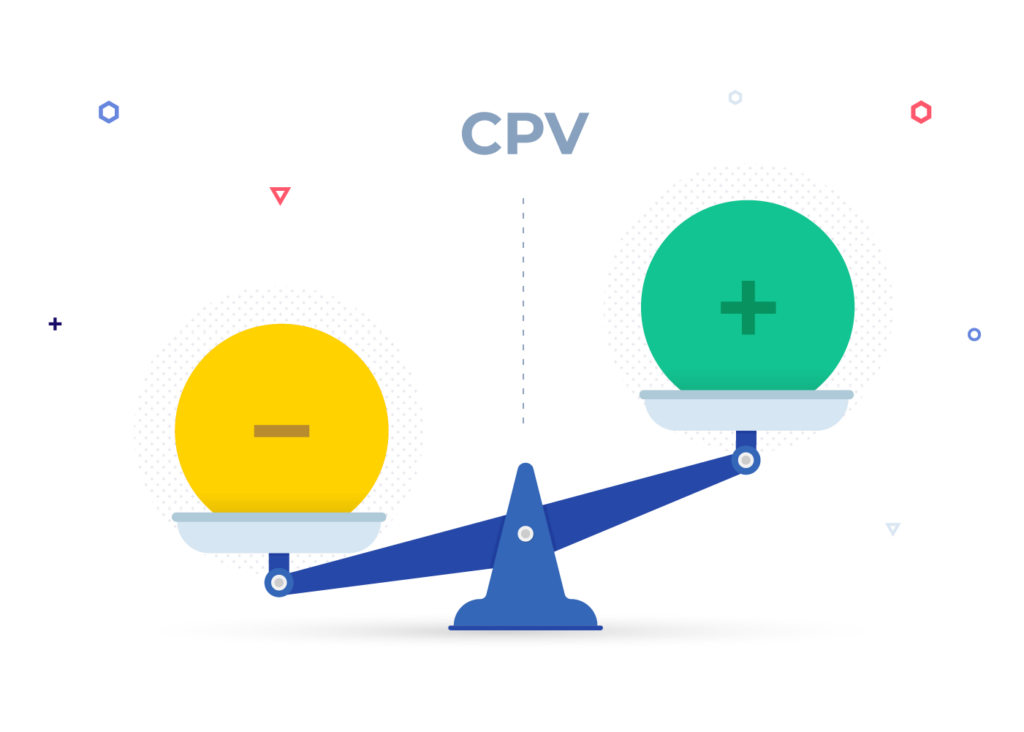
Here are some more details on the CPV/CPM cost model with domain redirect traffic:
- It takes only small fractions of a dollar, to begin with, so one can say it’s budget-friendly.
- It enables high volumes of traffic.
- It’s quickly actionable enabling Real-Time-Bidding auctions.
- RTB ensures the highest offered CPV wins.
- It allows budget capping and spend estimations.
- It has proven results if combined with rule-based optimization.
To give you the full picture of the situation, it’s worth knowing that:
- It may seem a bit more expensive than with other types of traffic, eg. pop.
- You risk burning your budget quickly if you don’t optimize it properly.
- High volumes of traffic need testing, thus additional money input.
INVESTING:
Again, running affiliate campaigns requires money input. Don’t be afraid to invest and then bid up. The best bidding strategy for domain redirect traffic would be:
- Set bids for verticals and your offers.
- Test and pick the best-performing targets and then bid up on those.
- Optimize your domain redirect campaign, see if it converts, and bid up more.
- Scale up your zero-click ad campaign.
When it comes to bidding — bid smart, bid big should be your mantra by now. Knowing how, when, and where to bid and pause is the key. If you’re a newbie to the industry, start with a smaller budget and lower bids. You need to know that testing burns budgets, but the more data you get out of it the better for your future affiliate ventures.
Once you’re past that phase, bid on well-performing sources while stopping the worse ones. Following this practice allows you to invest only where it’s worth it, and avoid wasting your resources.
KEY TAKEAWAYS:
Do not spend all your money, time, and energy on running tests only! Plan how long you can afford to keep such research going, and then take appropriate action.
Knowing how to read the data identified by testing is the key. If you don’t, then you’d better learn how to analyze it asap. Alternatively, have a tracking solution and a traffic source integrated to get a clear view of all the needed information. Let them do most of this mundane analytical work for you.
But before you decide to go full steam ahead, let us pinpoint a few things to make sure of first:
- Always plan how, when, and where to invest but don’t forget about the testing phase!
- Think how long you can afford to run tests, and avoid spending all your resources and energy on doing just that.
- Once you identify what targets are performing well, bid on those. Also, pause the unprofitable ones.
- Keep track of your data (tracking solution is a must!) and observe user behavior.
- Optimize your domain redirect ad campaigns — in this way you’ll avoid wasting your time, energy, and resources.

HOW MUCH IS THAT:
Traffic sources rarely give affiliates a set pricing per campaign. Use a Traffic Calculator tool (if your ad platform provides one). This handy tool helps affiliate marketers in estimating how much running domain ad campaigns can roughly cost and how much they’d need to spend in order to receive traffic. But there’s more to that.
- Budding affiliates most frequently ask about what’s the minimum amount to just try out domain ads and see if it works. Usually, the answer is the minimum top-up a given ad exchange accepts.
- Next would be what’s the minimum or most optimal budget to run profitable campaigns with. This usually revolves around $500 to $1000 and should suffice to start, run first tests and learn a couple of lessons.
- So the ultimate answer to the pressing question of how much domain redirect traffic actually costs is exactly how much one invests in it. We’ve established that quality comes for a price but with so many tips and tricks to aid the efforts can make domain redirect traffic ad campaign an easy and profitable choice.
Want To Get An Ultimate Answer To How Much Domain Redirect Traffic Actually Costs? Head Here!
Best targeting and optimization practices for domain redirect traffic.
If you’ve got your offers checked, landers created and you’ve already managed to identify the best-performing sources during the testing phase, here’s what’s left. The last step in this ultimate journey to domain redirect advertising would definitely be campaign targeting and optimization.

You already know that most of the time you’re able to run broad, whitelist, or keyword campaigns with domain redirect. And you’ve probably used the first one, the Run-of-network while testing.
Also, while setting up your campaigns you chose your GEO targeting, set bid caps, opted for device type (desktop or mobile), or whether to receive adult or mainstream traffic. You’ve even gone as far as setting the day-parting.
Especially in the case of domain redirect traffic, keyword targeting may play a crucial role. It’s worth remembering that the redirects are, in fact, based on wording similarities and misspellings. Hence, going for such an option seems like a reasonable thing to do while working on your zero-click traffic targeting and optimization.
Use generic keywords or broad match keywords to broaden your traffic search. It simply allows you to get more matches, e.g.: taxes or insurance are components of many more phrases than with the exact-match keywords like premium one-bedroom apartment insurance.
Naturally, none of the optimization practices would be possible if it hadn’t been for the tracking software. Since we’ve already mentioned how important having a tracker is, if you still don’t have one then get it real quick!
Learn More About Best Targeting And Optimization Practices For Parked Domain Advertising Here!
The ultimate guide to success in domain redirect advertising.
Whether you’re an experienced or a budding affiliate, using this ultimate how-to guide will surely help you find out what works best for your offers… or maybe a figure-making niche.
Since you’ve put all that effort into mastering domain redirect traffic it’d be a shame not to use it. Remember to stick to the good old practices of affiliate marketing while taking account of all the variables and dynamics of the industry. Scaling up your parked domain ad campaigns has never been easier!

Put all this information into practice to propel your efforts:
- Do your research on domain redirect advertising.
- Select offers suitable for zero-click traffic ads.
- Compare traffic sources available on the market and make your choice who to partner up with.
- Establish clear goals of your parked domain ad campaigns — testing, scaling, quick or steady profit?
- Research relevant keywords, matching verticals, and discover niches that could boost your zero-click campaign!
- Don’t forget about how important landing pages are, they’re the exact place where a user meets your offer.
- Estimate your advertising budget — plan how long you’re able to afford the testing and how much budget will you have left for scaling it up.
- Track all possible data and your parked domain advertising performance to enable AI-powered solutions and campaign optimization phase.
- Always start with running tests to see what sources or targets are worth focusing on, and which units should be dropped.
- Once you’re able to identify the best performing targets, bid up.
- Have your fair share of the domain redirect traffic while boosting your campaigns, don’t loiter and bid up to get more traffic.
- Optimize your campaigns using automated tools, e.g. Rule-based-optimisation, which enables quick reaction to any sudden market changes.
- Talk to your traffic source representatives to get as much industry insights and knowledge as possible, they truly know what can work best for you.
- Invest in your campaigns and scale up!
Start Domain Redirect Advertising Now!
Kinga Gawron


